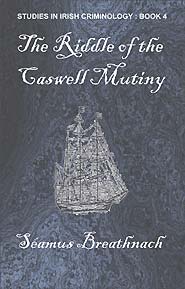
The Riddle of the Caswell Mutiny
by Seamus Breathnach
- Number of Pages: 265
- ISBN-10: 1581125771
- ISBN-13: 9781581125771
- Publisher: Universal-Publishers
- Year: 2003
- Category: History & Biography, History & Biography
Synopsis
In December 1875 captain George ‘‘Bully’ Best found himself in Buenos Aires without a crew and without a cargo. His men had for the most part deserted him. Before making his way to Antofogasta, where he loaded up with Saltpetre (nitrate), he recruited a‘ mixed crew’ of Greeks and British.The British refused to sail with the Greeks, and rather than allow them onshore to see the British Consul, captain Best beat them and put them in irons.. Even before the Caswell sailed for Queenstown on January 1 1876, an Irishman and a German jumped ship and were never heard of again.
Obvious tensions might lead one to expect a British mutiny. And perhaps this might have happened had not the Greeks beaten them to it. For some unexpla-ined reason the Greeks, under the influence of 'Big George' Peno, mutinied and killed the captain, the first and second mates, and the black Welsh steward. All four bodies were lashed to an anchor and thrown overboard.
By February two of the mutineers, the brothers Pistoria, escaped by boat up the river Plate to Buenos Aires. The remainder drifted under Greek command until March 11th, when the British counter mutinied and killed two of their captors. A third mutineer was brought back to Queenstown to be tried for Murder on the High Seas.
Young Christos Emmanuel Bombos found himself imprisoned with a sixty three year old Fenian named Thomas Crowe. Both men provided the spectacle of a 'double hanging' in Cork's male prison. A full eyewitness account is given of the executions, which happen to be one of the most striking events in nine-teenth century penological literature.
Three years later one of the escaped mutineers was arrested in Monte Video and a second trial was staged in Cork.
Of the sixteen persons who set out from Buenos Aires:
*two jumped ship; *four were murdered in the mutiny; *two were murdered in the counter-mutiny; *one was hanged in 1876 and another in 1879; *and six returned to tell the tale.
About the Author
For almost twenty years Seamus Breathnach has worked (as lecturer and Course Director) on a two-year Postgraduate Diploma course in criminological studies, the only taught course of its kind in the Republic of Ireland. Inaugurat-ed under the auspices of the CDVEC (the City of Dublin Vocational Education Committee), the course was inspired by the late James Hickey, Principal at the College of Commerce, Rathmines. It was James Hickey's ambition to have a more culturally-orientated social science -- and a Criminology -- rooted in Irish history and in Irish historical concerns. With his untimely death, however, and the takeover by DIT (the Dublin Institute of Technology), the arts, music, and the social sciences (including criminology) succumbed generally to a less elevated mindset.In partial fulfillment of his debt to CDVEC, the author, who shared the late James Hickey's enthusiasm, has sourced and researched the present work pers-onally. The Caswell mutiny, though removed from
mainstream criminology and written like a novel, is an enquiry into a little known mutiny in 1876. It also
contains a unique insight into the nineteenth century penological penchant for capital punishment.



 View or Post a Review at Amazon.com
View or Post a Review at Amazon.com